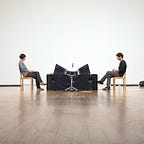Countryside research
One of the practical problems to be dealt with, when trying to receive weak radio signals like the signal from the LES-1 satellite, is the problem of radio interference. So far, all of our research has been happening in the middle of the city of Berlin — specifically, on a rooftop in Friedrichshain.
Practically speaking, any signals that we get from this location will be subject to interference from everything else in the city that pumps out radio waves all around us — so, every mobile phone, every smartphone, every wi-fi router, every laptop, every radio station, every taxi radio or two-way radio. In short, millions of little extra bits of radio signal will always be swirling around us in the air.
This is an eternal problem for anyone who wants to receive quiet signals — from amateur radio enthusiasts right up to national governments and militaries. In fact, the US government has attempted to fix this problem by declaring a 34,000-square-kilometer area of Virginia and West Virginia as the United States National Radio Quiet Zone (NRQZ), with strict limits on all radio transmission within this zone.
It’d be nice to be able to declare an official Kovács/O’Doherty national artistic-research radio quiet zone, but unfortunately, our resources are slightly more limited than those of the government of the United States. So, we did the next-best thing, which is to pack up our smallest antenna, get on the train, and head out into the countryside.
There is an artist’s community, about 70 kilometers (45 miles) outside of Berlin, called Ponderosa. We’ve been out there plenty of times before, but it happens to also be very well-suited to the kind of thing we’re looking for: quiet countryside, away from urban radio noise, and with big open fields nearby to go and stand in. This past weekend, we spent some time setting up and monitoring. We were hoping that we could set up for a couple of passes of the LES-1 overhead, and hopefully get a signal from it that would be clearer and stronger than the one we would otherwise get in the city.
And… the plan worked.
After we got back from the fields, we reviewed the slice of radio spectrum that we had recorded. And there, just below 237 mHz, was the tell-tale wavering signal of the LES-1. The signal was slowly shifting lower in frequency over time, due to the Doppler shift caused by the speed of the satellite as it crosses the sky.
The signal we got was nice and clean, relatively speaking. We were able to isolate it, and make a video from an excerpt of it (derived from I/Q data presented in a waterfall spectrogram played back via Gqrx SDR). From there, it’s just one more step to upload it to YouTube and set it afloat on internet waters. Make sure to play this full-screen, at maximum quality, with speakers turned up…
(A nerdier version, showing things like frequency, FFT settings, and receiver options, is also available, on YouTube, here.)
There are some follow-up paths coming out of all of this. First among them would be to try to do the same experiment, but with a more accurate (and thus bulkier and more awkward) antenna. But our initial countryside research is done, and for now it’s time to head back to the city.
We’ll finish with a picture of the LES-1 — at least, conceptually speaking. As the satellite pass was happening, we took a photo of the part of the sky that it was passing through, at the time when it was at its maximum altitude. It’s pretty much dead-centre in the upper half of the sky in this photo (so, above and to the right-hand-side of the moon). You’ll need to use your imagination, but here it is:
